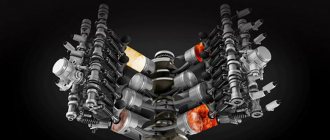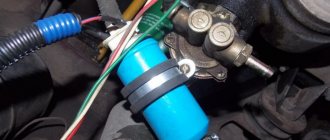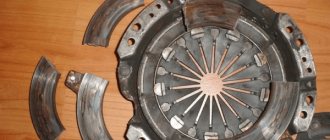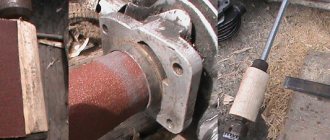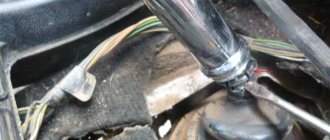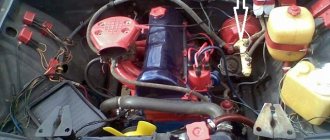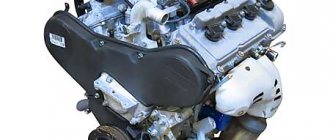To restore the outer surface of cylinder liners It is necessary to clean the outer surface of the liner from scale and corrosion. To clean the surface of the sleeve you will need a steel brush and lathe.
To clean cylinder liners, there is a special installation OM-21601.
Cleaning material for installation OM-21601 : metal sand, stone chips, flux.
Productivity of the OM-21601 installation : 40 cylinder liners per hour.
Operating pressure of compressed air of the installation for cleaning sleeves : 0.5-0.56 MPa.
Elimination of cavitation damage to cylinder liners using epoxy composition.
Cavitation damage to cylinder liners is eliminated using coatings based on epoxy resins and is eliminated in the following sequence:
- Cleaning the surface of the cylinder liner (to a metallic shine);
- Degreasing the surface of the cylinder liner (with technical acetone);
- Preparation of the epoxy composition (after adding the hardener, the composition must be used within 20 minutes);
- Applying an epoxy composition to the surface;
- Hardening of the applied layer (at a temperature of 20 degrees Celsius for 3 days).
Before applying the epoxy compound to the cylinder liner, the liner must be raised to a temperature above 40 degrees Celsius. The epoxy compound is applied to the surface of the cylinder liner with a special spatula.
The epoxy compound should not be exposed to water, oil or dirt. Leakage of epoxy compound onto the cylinder liner seating strips during repair of cylinder liners .
A method for eliminating cavitation damage to cylinder liners by welding steel tape.
There is a simple method of contact welding of steel tape to eliminate cavitation damage to the cylinder liner.
To weld the steel strip to the surface of the sleeve, use installation 011-1-07. The steel strip is cut from a steel sheet 0.3 mm thick. The damaged area of the sleeve should be covered with steel tape by 5-10 mm. The steel strip is welded with one weld point to the surface of the sleeve, so that the weld point is no further than 1-2mm from the edge of the strip. The lower part of the steel strip is welded symmetrically with the upper one welding point. Then the edges of the tape are welded.
For welding, it is recommended to use wide electrodes in order not to destroy the sleeve.
The diameter of the electrodes is 150 mm, the width of the upper working part is 5 mm, the bottom is 12 mm.
When the steel strip is already welded, they begin to grind the sleeve belts to the nominal size. A grinding machine is used to grind the cylinder liner flanges. We carefully install the cylinder liner on the grinding machine so that no deformation of the liner occurs. Please ensure that the welded layer does not protrude beyond the surface of the seating belt.
We begin to restore the inner surface of the cylinder liners. After cleaning, monitoring and eliminating cavitation damage on the outer surface of the cylinder liner and restoring the seating belts, it is necessary to process the inner surface of the cylinder liner to the repair size, that is, increase the internal diameter of the cylinder liner by 0.5-0.7 mm. depending on the engine type.
Sleeve
Sleeve
(from German Hülse)
1) G. artillery - part of an artillery shot (See Artillery shot), a thin-walled metal glass intended for placing a powder Charge, auxiliary elements for it (copper reducer, flame arrester, etc.), ignition means (capsule) and for obturation of gases in the process shot (see Obturation). In unitary cartridges, the cartridge combines the projectile (bullet), charge, and ignition medium into one whole ( Fig. a and b). 2) G. cartridge of small arms - a miniature copy of G. artillery. Together with the powder charge and the bullet fixed in the muzzle, it constitutes a unitary small arms cartridge ( Fig. , b). 3) Hunting cartridge cartridges come in metal and cardboard.
Cases: a - artillery cartridge case for cartridge loading, b - artillery case for separate loading: 1 - muzzle, 2 - slope, 3 - body, 4 - nipple, 5 - point for the primer sleeve, 6 - flange, 7 - bottom cut; c - unitary small arms cartridge: 1 - bullet, 2 - gunpowder, 3 - cartridge case, 4 - primer, 5 - cap with rim.
Source: Great Soviet Encyclopedia on Gufo.me
Meanings in other dictionaries
- sleeve - G'ILZA, sleeves, female. (German Hulse - pod). 1. A paper cigarette cartridge filled with tobacco. Cases with a mouthpiece, without a mouthpiece. 2. A tube closed at one end, usually metal, that serves as the shell of a cartridge for a firearm (special). Ushakov's Explanatory Dictionary
- sleeve - borrowed sleeve. from it. Hülse “shell, sleeve; husk, peel." Etymological Dictionary of Max Vasmer
- cartridge case - CASE An integral part of a small arms cartridge (made of cardboard, metal), which contains gunpowder, a bullet, a primer, a wad (in a bench cartridge). (Terminology of sports. Explanatory dictionary of sports terms, 2001) Dictionary of sports terms
- sleeve - Sleeve, s, w. 1. In firearms: tube, glass (in 2 digits) for a bullet, charge. 2. A paper cigarette cartridge filled with tobacco. | adj. sleeve, oh, oh. Ozhegov's Explanatory Dictionary
- CASE - CASE (German Hulse, lit. - shell) - 1) artillery casing - part of an artillery ammunition supply, a thin-walled metal glass designed to accommodate a propellant charge, ignition means (primer sleeve, capsule), etc. Large encyclopedic dictionary
- sleeve - s, w. 1. In firearms: a cylindrical tube with a closed bottom in which the powder charge and ignition medium are placed, and the upper part is adapted to secure the bullet (projectile). Small academic dictionary
- sleeve - German - Hulse. Swedish - hylsa. The word “sleeve” became widespread in the Russian language at the end of the 18th century. and was borrowed from German (Hulse - “sleeve, shell”). Etymological Dictionary of Semenov
- sleeve - Sleeve/a. Morphemic-spelling dictionary
- sleeve - Sleeve w. German paper, glued, and sometimes tin tube, for rockets and other funny lights; sleeve, related to it. Dahl's Explanatory Dictionary
- sleeve - orf. sleeve, -s Spelling Dictionary Lopatin
- sleeve - Borrowing from German, where Hiilse - “shell, sleeve.” Krylov's etymological dictionary
- sleeve - (German hulse, lit. - shell) - part of a ammunition supply (cartridge, projectile), a thin-walled metal glass designed to accommodate a powder charge, propellant charge (bullet, shot), ignition means (primer sleeve, capsule), etc. Large legal dictionary
- sleeve - noun, number of synonyms: 3 cigarettes 22 quills 1 flare 2 Dictionary of synonyms of the Russian language
- sleeve - Sleeves, w. [German Hulse – pod]. 1. A paper cigarette cartridge filled with tobacco. Cases with a mouthpiece, without a mouthpiece. 2. A tube closed at one end, usually metal, that serves as the shell of a cartridge for a firearm (special). Large dictionary of foreign words
- sleeve - sleeve 1. A cylinder (usually metal) with a bottom, designed to hold a charge and connect parts of a cartridge or projectile. 2. A paper tube, a cigarette cartridge, a cigarette cartridge filled with tobacco. 3. A part of a technical device in the shape of a tube or cylinder. Explanatory Dictionary by Efremova
- sleeve - Sleeve, sleeves, sleeves, sleeves, sleeve, sleeves, sleeve, sleeves, sleeve, sleeve, sleeves, sleeves, sleeves Zaliznyak’s Grammar Dictionary
- sleeve - SLEEVE -s; and. [German Hülse] 1. In firearms: a cylinder (usually metal) with a bottom designed to accommodate a powder charge and firmly connect it to a bullet or projectile. G. from a shell. Strelyannaya city. Kuznetsov's Explanatory Dictionary
- Blog
- Jerzy Lec
- Contacts
- Terms of use
© 2005—2020 Gufo.me
Boring engine cylinder liners
Boring of cylinder liners is carried out on a diamond boring machine. The machine 278, 278N for boring cylinder liners is equipped with a special device for fastening the liner.
Boring of cylinder liners is carried out, usually in one pass.
Mode for boring cylinder liners on a diamond boring machine :
- Spindle speed 112 rpm .
- Tool feed 0.2 mm/rev.
- Cutting depth 0.3 mm.
The recommended boring mode for cylinder liners ensures minimal taper, ovality and roughness.
- Ovality and taper are no more than 0.04-0.05 mm.
- The surface roughness of the cylinder liner is no more than 2.5-1.25 microns.
To bore cylinder liners, special cutting tools are used - carbide cutters
When boring cylinder liners, it is necessary to monitor the wear of the cutter, since with increased wear, the parameters of ovality, taper and roughness will increase. The most optimal number of bored cylinders with one cutter is 5-7 pieces.
What is an engine liner called?
The cylinder block liner is a metal cylinder that represents the inner shell (insert) of the cylinder block. There are two types of liners used in automobile engines:
- “dry” liners are those that are installed in the cylinder block directly at the stage of manufacturing a new engine, and channels for supplying coolant in the area where this liner is located are not provided;
- “wet” sleeves are those that, on their outer side, are in contact with the refrigerant, which circulates between the sleeve and the body of the block.
Accordingly, lining is the process of installing liners into engine cylinders.
The cylinder block can be lined in the following cases:
- at the engine production stage;
- at the stage of engine repair.
Cylinder liner grinding
Very often, instead of boring the inner surface of cylinder liners, grinding is done on a grinding machine.
Grind the cylinder liners using flat abrasive wheels with a grain size of 40 of medium-soft hardness made of white electrocorundum. Grinding of sleeves is carried out in two passes:
- Rough grinding;
- Finish grinding;
Coolant:
- Water with 2% soda ash added.
- Soap.
Table movement speed : 0.3… 8 m/min.
Grinding wheel speed : 5600 rpm.
Part rotation speed : 160 rpm.
Grinding wheel speed : 25… 35 m/s.
Part speed : 55… 65 m/s.
Cross feed of the circle : 0.01 ... 0.03 mm.
Cross feed during finishing pass : up to 0.005... ...0.015 mm.
C table movement speed : up to 0.3.. 4.5 m/min.
Grinding of cylinder liners is characterized by a high metal removal rate and ensures the specified high accuracy and the required roughness of the machined surface of the cylinder liners. These parameters allow you to achieve good honing quality and reduce the cost of abrasives.
Honing of engine cylinder liners. After boring or grinding operations, the inner surface of the liner can be honed. Honing is carried out on a 3A83 vertical honing machine.
Cylinder block liner defects
So, among the main defects associated with the sleeve, the following should be highlighted:
- wear of the outer surface of the liners;
- formation of cracks in cylinder block liners;
- fracture of the cylinder liner collar;
- defect of the inner surface of the sleeve (mirror);
Wear on the outer surface of liners is quite common. Most of the outer surface of the BC liner is in contact with the coolant. Due to the vibration of the liner during engine operation, bubbles appear that explode at the outer wall of the liner, this process is called cavitation and leads to cavitation wear, as well as corrosion processes.
Vibration and corrosion cause microcracks to appear in the liner, through which, under the influence of high pressure, coolant penetrates into the engine crankcase and forms an emulsion in the engine oil.
This defect can be eliminated by applying polymer composites to the damaged areas. But, unfortunately, such repairs will not provide a complete guarantee that the problem will be completely eliminated. It may be necessary to replace the sleeve in the near future.
In order to prevent corrosion processes and cavitation wear of the outer walls of the liner, the car owner needs to use only high-quality special coolants (antifreeze or antifreeze), often recommended by the engine manufacturer itself.
- Another common problem is the formation of cracks in the cylinder liners. Often, cracks in the cylinder head and cylinder head appear as a result of improper operation of the unit (long-term engine operation at high speeds, use of fuel not recommended by the power plant manufacturer, etc.).
An important factor in the manifestation of the defect is a sharp change in the speed of rotation of the engine crankshaft before the cutoff on a cold engine, as well as the use of low-quality lubricants and coolants.
It is also worth mentioning the internal combustion engine repairs carried out at a service station with non-compliance with technical standards for this power unit. It is also impossible to exclude cases of cracks in the cylinder block liners caused by defects in the production of the product at the manufacturer.
Indirect symptoms of the described defect may be:
- violation of the engine temperature regime when the thermostat is working;
- subjective feeling of decreased engine power;
- the appearance of an emulsion in the engine oil, as well as an emulsion in the expansion tank;
- the smell of exhaust gases from the expansion tank;
These signs may lead to a visit to a qualified service station for the purpose of conducting in-depth diagnostics and identifying possible cracks in the cylinder block liners.
The main methods for identifying cracks are: radiography and the method of identifying cracks using dyeing chemical solutions. If a defect is detected, the main and only method of elimination is to replace the liner, since a defective liner with a crack cannot be repaired.
Broken cylinder liner collar
The collar seat is a rounded, smooth recess located in the engine cylinder block that secures the liner in the block. In order for the sleeve to fit completely around the entire perimeter of the seat, the collar must sit exactly in the recess. A head gasket is installed at the top of the cylinder block, which must lie exactly against the top of the shoulder seat.
When tightening the bolts, the cylinder head is strongly pressed against the cylinder block, while the gasket between them must withstand maximum pressure. It is through the bolts and gasket that a large force is transmitted to the shoulder seat. For this reason, it is very important that the force is transmitted through the gasket to the seat strictly vertically.
A fracture of the cylinder liner collar may result from:
Currently reading:
Replacing tie rods and ends: what you need to know
Jun 21, 2020
What oil to fill in Kia Rio: what you need to know
Jun 21, 2020
- distortion in the area of the liner collar seat;
- violations of processing technology during the repair and restoration of cylinder block liners;
- cylinder head gasket of unsuitable height and dimensions;
- the presence of foreign particles between the cylinder block liner and the collar (chips, sealing agents, remnants of an old gasket, etc.).
To prevent the liner collar from breaking, it is necessary during engine assembly:
- ensure clean surface treatment of the collar and cylinder block;
- make sure the quality of the rings installed under the sleeves;
- The thickness of the cylinder head gasket must comply with the technical requirements for this product.
When installing the cylinder head, it is necessary to tighten the bolts with a torque wrench with the force specified in the technical documentation, according to the correct bolt tightening sequence when installing the cylinder head.
Methods for eliminating a liner defect will depend on the degree of damage to the cylinder head collar. As a rule, a strip of steel is welded to the sleeve, or the sleeve is replaced.
If you detect a liner defect in a timely manner and eliminate it, then you can avoid more serious consequences in the future, as well as save on engine repairs. The fact is that if there are defects in the liner during active operation of the vehicle, the piston itself, the crankshaft connecting rod, etc. often fail.
Defect in the inner surface of the liner
When operating a vehicle on dusty roads and in industrial cities, dust particles enter the internal combustion engine cylinders through the air filter or leaky air duct connections, as well as with dirty fuel and poorly filtered engine oil.
The result is an impact on the sleeve mirror with the effect of sandpaper (scratches and nicks on the sleeve mirror). Over time, the scratches become more numerous, and then the tightness of the fit of the piston rings to the mirror wall of the liner critically decreases, which leads to a drop in compression in the cylinder.
We also recommend reading the article on how to bore and liner a cylinder block. From this article you will learn about what nuances and features should be taken into account when carrying out these operations.
It is possible to restore the mirror of the inner surface of the liner using the chrome plating method, and in cases of critical wear on the surface of the liner, which cannot be eliminated by this method, the damaged liner will need to be replaced.
In order to prevent abrasive from entering the internal combustion engine cylinders, the car owner must carry out maintenance in accordance with strictly defined regulations. When carrying out maintenance, you need to focus on checking the tightness of air duct connections, and also use oils and filters recommended by the manufacturer.
Manufacturing the required sleeve (Alusil, gray cast iron)
Due to the large differences in cylinder block concepts, as well as the very difficult to estimate requirements for parts and materials, it is not possible to offer ready-made liners or semi-finished products for each individual case. Every engine repair shop that carries out minor to major repairs of aluminum cylinder blocks must, for this reason, either manufacture its own liners from aluminum or gray cast iron, or order their production.
To make liners, an engine repair shop requires a lathe with a fixture large enough to clamp the workpiece (Figure 1). Due to the length of the sleeve and the fact that most likely there will not be any material available in the form of a rod or tube, it is recommended to use a suitable receiving device in the tailstock (rip washer, center, etc.) when making sleeves on a lathe. (image 2)
| Image 1 |
Aluminum sleeves
For the production of aluminum sleeves, ALUSIL® cast cylindrical blanks are available in two sizes (Fig. 3 and 4). The material composition of these blanks is identical to that of the original ALUSIL® cylinder blocks. This material is, however, suitable not only for ALUSIL®-6noks, but also for the repair of blocks manufactured using the LOKASIL® and Silitec® methods, as well as for laser-alloyed cylinder sliding surfaces.
| Image 3 |
| Image 4 |
| D | d | L | p° KS |
| 85mm | 74 mm | 160mm | 89 571 190 |
| 105mm | 84mm | 160mm | 89 572 190 |
Gray cast iron sleeves
In principle, any wet or dry cylinder liner that has a suitable diameter and can be processed for the desired purpose is suitable for the production of the required gray cast iron liners.
Note
From the MSI Motor Service International GmbH catalog on CD or from the MSI Motor Service International GmbH Internet shop (the Internet address is on the back of the brochure), you can select suitable gray cast iron sleeves under the heading “Looking by size” in the sleeves section.
Sleeve dimensions, interference dimensions
The required repair sleeves can be manufactured according to the following dimensions. The dimensions apply to both ALUSIL® and gray cast iron sleeves.
If the exact geometry of the liners being manufactured is observed, it is recommended that the thickness of the liner wall be kept as large as possible before pressing. This means that the liners are brought to the required wall thickness of 1.5 to 3 mm only after hot pressing and final processing by drilling and honing. Thus, the sleeves before and after installation remain mostly round and can be inserted well into the main hole during hot pressing. Due to the greater thickness of the material, during hot pressing there is slightly more time until the temperatures equalize and the liner hardens. Also, the measurement of the outer diameter during the manufacture of a liner is more accurate than that of a thin liner, which can only be deformed by several hundredths of a millimeter under the pressure of the measuring tool.
| Cylinder liner size | Setpoints | |
| Case length | L | = Sleeve length + 0.2 mm |
| Cylinder liner - outer diameter | = A + X | |
| Overlap (interference size) | X | = 0.08-0.1 mm |
| Required wall thickness after | >= 1.5 mm | |
| cylinder finishing | ||
| Maximum wall thickness after | 3 mm | |
| cylinder finishing | ||
| Surface roughness on the outside | R2 6.3 (JM | |
| nom sleeve diameter | ||
| Roughness for others | R2 25 |JM | |
| processed surfaces | ||
| Permissible out-of-roundness of the sleeve | 0.02 mm | |
| Case collar dimensions | Setpoints | |
| Bead diameter | ||
| Bead height | = C + 0.2 mm | |
| Main cylinder bore dimensions | Setpoints | |
| Diameter of the main hole of the sleeve | A | |
| Diameter under collar | IN | |
| Height under collar | WITH | = 4-5 mm |
Image 1
Recommendation
Due to the very small difference in size between the sleeve and the main hole of the sleeve, it often happens that the main hole is drilled a few fractions of a millimeter larger, and the already manufactured sleeve is therefore small for this diameter. Therefore, it is recommended to first make the main hole of the liner in the cylinder block, then measure it with a device with great accuracy for the internal surfaces, and only then sharpen the liner to a suitable size. This ensures the necessary overlap (tension).
